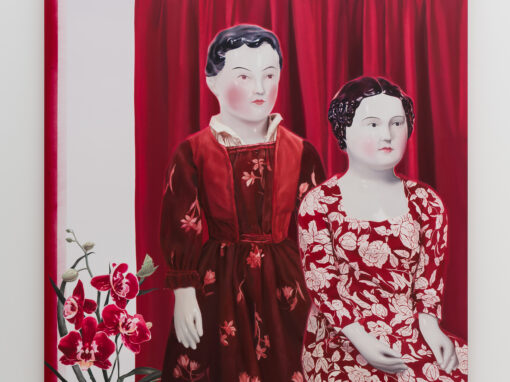Allegory: The Sharp and the Smooth
Jiwon Choi
Jiwon Choi paints dolls. In fact, she paints one particular type of doll: German bisque dolls, so named because they have primarily been produced in Türingen, Germany since the 1840s. More commonly referred to as porcelain dolls, bisque dolls, or china dolls, they became quite popular as children’s toys in Germany and France between the 1860s and 1900s. Today, they are widely considered to be high-end craftworks, which are coveted by antique collectors around the world. These dolls come in many different variations, such that connoisseurs can identify the manufacturer of a given doll by the shape of the eyebrows, eyes, or lips. For example, the dolls in Choi’s paintings typically have eyes that are simply drawn onto the smooth porcelain surface, but some varieties have separate eyeballs inserted into holes for the orbit. In most cases, only the exposed parts of the dolls—such as the head, upper torso, hands, and feet—are made from porcelain, with the rest of the body sewn from cloth. Similarly, in most of Choi’s paintings, only the face or upper body of the doll are shown, thus emphasizing the blank facial expressions. Interestingly, Choi’s dolls show many subtle differences from the real dolls. For example, the pupils seem to be a bit smaller, the “flesh” has a more grayish color, and the corners of the mouth hang downward. Just like the real dolls, however, Choi’s dolls have blushing red cheeks, which are the only clue to the emotional agitation they are hiding inside.
Jiwon Choi introduced her series of doll paintings at the exhibition Cold Flame, held at ThisWeekendRoom Gallery in May 2020, featuring works that she had produced since the fall of 2019. Gently glistening in bright indoor light against a dark background, the porcelain surface of the dolls creates an impression of purity and innocence, enhanced by its soft curved reflections and hard but fragile texture. Rather than the innocent girls usually associated with children’s toys, however, Choi’s dolls represent mature women, reminiscent of statues of the Virgin Mary. Indeed, the crying face in The Crying Woman (2019) instantly recalls the epiphany of the Virgin Mary. In many of Choi’s works, the dolls look as if they are about to come to life, like a supernatural novel. Some of her dolls seem to be moving, such as the doll in Untitled (2019), which is trying to enhance her faint eyes by putting in brown contact lenses with distinct pupils. This work shows that the artist intentionally paints the dolls with dim eyes.
With their small pupils and blank expressions, Choi’s dolls seem to represent the artist’s perception of herself as a young woman in her twenties, as well as other women of her age, who are expected to behave like porcelain dolls, showing no emotion. Many of her paintings feature two or more such women, who seem to share the same emotions yet do not reveal them to anyone (least of all the viewer). This inner narrative is further elicited by the artist’s composition, often having all of the dolls face forward or to the same side. One notable exception is Indifference (2019), in which four women on the right look at a crying woman on the left. Tears pouring out from an expressionless face must represent an extraordinary emotion, yet the women never betray these emotions to the viewers, revealing them only through their mutual empathy while facing each other.
The works of Choi’s Fog of Thorns series (2021) show a large close-up of a doll’s face, bisected by the stem or branch of a plant. These plants seem to be thorny flowers or acacias, again symbolizing the intense emotions coursing through inner minds of the non-existential porcelain dolls. In Thorn Flowers and a Woman, a woman in black stands placidly before a enlarged background of beautiful red flowers and sharp thorns. In Roomin’ Red, idealized red orchids bloom next to two women wearing red, who look to the right, as if avoiding eye contact with the viewer. In Melancholia, on the other hand, the women in the foreground are backlit by a bright full moon that heightens the sense of psychological agitation. The striking use of symbolism in these recent works extends the prevailing allegory of the dolls, leading to subtle yet exciting variations. Above all, the artist’s composition, juxtaposing the realistic presence of the lovely porcelain dolls in surreal settings, maximizes the dramatic emotion, ultimately yielding unparalleled beauty.
“To portray the emotions of the present era, which are so casually consumed and discarded, Jiwon Choi seized upon the visual characteristics of a porcelain doll, an icon of beauty that will easily shatter if handled without care. Her desensitized figures show no reaction, even when standing near exploding firecrackers or walking boldly on a dark forest road. The artist did not study the manufacturing process or materiality of the porcelain dolls, because such details hold no great importance to her. The only thing that matters for her is how to portray the fundamental principle. Born from such contemplations, the smooth and shiny porcelain figures faithfully and cleverly convey the emotions of our time that she wished to express.”
– Yi Gahyeon










